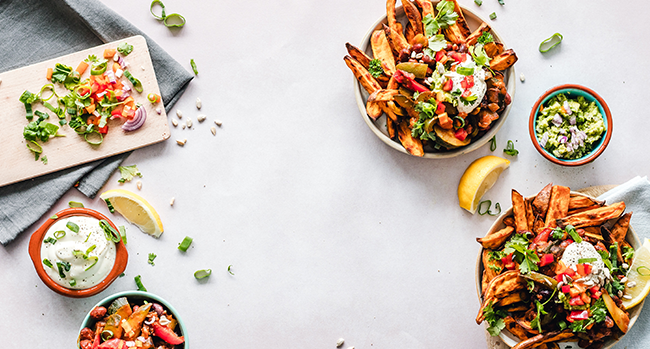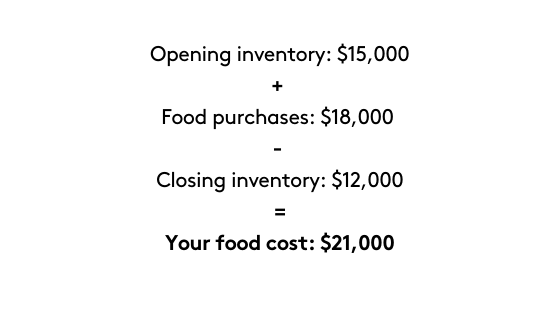Food cost is an essential part of your restaurant's budget. There are several aspects to take into consideration when determining the price of an item on your menu, that's why it's important to calculate your food cost.
In this blog post, we look at five key components that are crucial when calculating your food cost.

Food cost and accurately calculating food cost is one of the thorniest issues for many restaurants and QSR’s. Here are some tips to help demystify all the fuss and lead you to a clearer understanding of what you need to know.
First of all, food cost is a ratio, a comparison of the revenue you receive from a customer for a meal and the raw cost of the ingredients used to make that meal. Simply put, if it costs you $3,00 for ingredients for a menu item and you sold it for $10.00, your food cost would be 30%. That’s the easy part, but food cost can be a much more complicated reality and it’s often made up of many different actions and component activities in your establishment.
So that calculation is fine for a single menu item and of course, your food cost is made up if the many different transactions that happen over a specific period of time. For a restaurant, it’s typical to calculate a monthly food cost, it usually looks like this:

Let’s give it some numbers to see what it looks like:
 That’s interesting but not very meaningful. If we know the total of the food sales for the month, we can calculate this as a percentage, the most common way to measure food cost. So, your food sales were $68,000 for the same period, you would use the same calculation I used earlier, $21,000 / $68,000 = 30.8%, I’ll round it up to 31% here for ease. This means that all of the food you used and all the food sales you made for the month, 31 cents was used to generate each dollar of sales.
That’s interesting but not very meaningful. If we know the total of the food sales for the month, we can calculate this as a percentage, the most common way to measure food cost. So, your food sales were $68,000 for the same period, you would use the same calculation I used earlier, $21,000 / $68,000 = 30.8%, I’ll round it up to 31% here for ease. This means that all of the food you used and all the food sales you made for the month, 31 cents was used to generate each dollar of sales.
It makes sense that you would ask what an “ideal” food cost is. The answer is, “it depends!” Typically, high-end restaurants have higher food costs than a casual dining atmosphere and then a QSR or fast food restaurant generally has the lowest food cost. Your food cost is also driven by your management philosophy on pricing your menu items and the way you view purchasing your raw ingredients. “I only buy the best ingredients for my menu!” That’s nice but the “best” usually equals “expensive,” which isn’t always what’s needed. If you have a roasted red pepper and tomato bisque on your menu, do you use market-priced fresh tomatoes, or will a good quality canned product do the job? You can see here how it depends! Just remember that each of these decisions will be a financial decision and thus affect your menu pricing strategies and of course your food cost!
With food cost being so varied, here are our top 5 tips to help you keep your food cost under control.
.png?width=1053&name=Typsy%20%20We%20teach%20hospitality%20to%20the%20world%20%20typsy.com%20blog%20banner%20_%20(1).png)
Typsy’s 1000+ hospitality lessons are practical, effective, and fun! You can learn more about everything from finance to service and leadership skills.
Best of all, you can access Typsy as and when it suits you.
Learn your way - starting today.
1. Standardized recipes
This can be a huge challenge for a couple of reasons, you have three different line cooks and each one of them makes the menu item a little differently. This lack of consistency causes confusion, especially for your customers, for example, your grilled prawn entrée should always have the specified size and the number of prawns on the plate that goes in front of the customer, not some random amount that the line cook thinks “looks good!”
Standardized menus and recipes also help the kitchen staff. With the notoriously high staff turnover rates that restaurants suffer from, the more standardized you can make your ingredients and recipes, the easier it is to train staff members and keep your menu items consistent. Customers certainly notice any irregularities here and if they feel short-changed you won’t need to worry about food cost, as you won’t have any customers to sell to!
2. Pricing
Of course, the price you set for your different menu items directly relates to the food cost for that particular item. Is the price you’re charging fair? Does it cover the cost of the raw materials? Remember that after you pay for that 31% food cost, it means there is now only 69% of that dollar left to pay for employee wages and benefits, rent, insurance, electricity and all the rest of the direct and indirect costs of running a business. Don’t forget that you will still want to have a percentage left over for actual profit too!
3. Purchasing practices
Who is tasked with purchasing the ingredients used in your venue? What standardized systems do you have in place to purchase them? Each of the ingredients you buy should have a detailed set of specifications to go with them. When requesting quotes from your suppliers, provide them with your requirements so that when you sit down to do the purchasing, the quoted prices are the same every time. This really is a question of comparing apples to apples, be sure they are the same kind of apples and the same count per case! Yes, the food industry has standardized counts and measurements for what they sell, you need them too for what you buy!
4. Receiving
Who is responsible for receiving your food deliveries? Is each delivery checked, counted, weighed and the temperature checked? Or, does the food just get dumped on a loading dock or the back of the kitchen and put away sometime later? This can be an easy way for your delivery items to go missing.
Part of the receiving process should be accurate counts and weights on all applicable food items that you receive. When receiving the invoices, you need to check them for several things:
- the quantity received,
- the price per unit is correct and corresponds to the quotes you received,
- the math is correct on the invoice.
Invoices need to be “approved” and sent to accounting as soon as possible for payment. For instance, if any items are shorted from the order, if there is an incorrect price on an invoice or some other discrepancy, it must be noted at the time of delivery and signed by the delivery person to acknowledge the errors for timely follow-up. No one remembers mistakes that happened on a delivery last week. Document it.
5. Storage
All incoming products should be checked against the receiving criteria and stored in the appropriate place as soon as possible after the delivery is received. Remember to do two things here:
- Make sure your stock is correctly rotated to ensure proper stock rotation
- Ensure that all storage areas are securely locked
I also recommend having a supply of pens handy, use them to write the invoice price on the case as well as the receiving date. These two little steps save a ton of time and increased accuracy when it comes time to do inventory.
Remember that any inconsistencies or errors in any one of these areas can result in a food cost that exceeds expectations and puts your business in jeopardy. If you can get control over these critical areas of your foodservice establishment, you will be able to gain control over your food cost and thus, your ability to control profit.
Start your online hospitality Typsy training today, and watch our Better Food Cost Management course with Ryan Gromfin.
 |
Mike Walmsley, is the author of '69 Tips For Better Food & Beverage Profit'. Stay tuned for the next book in the series, '101 More Tips For Better Food & Beverage Profit', coming out soon on Amazon! |
You might also like: